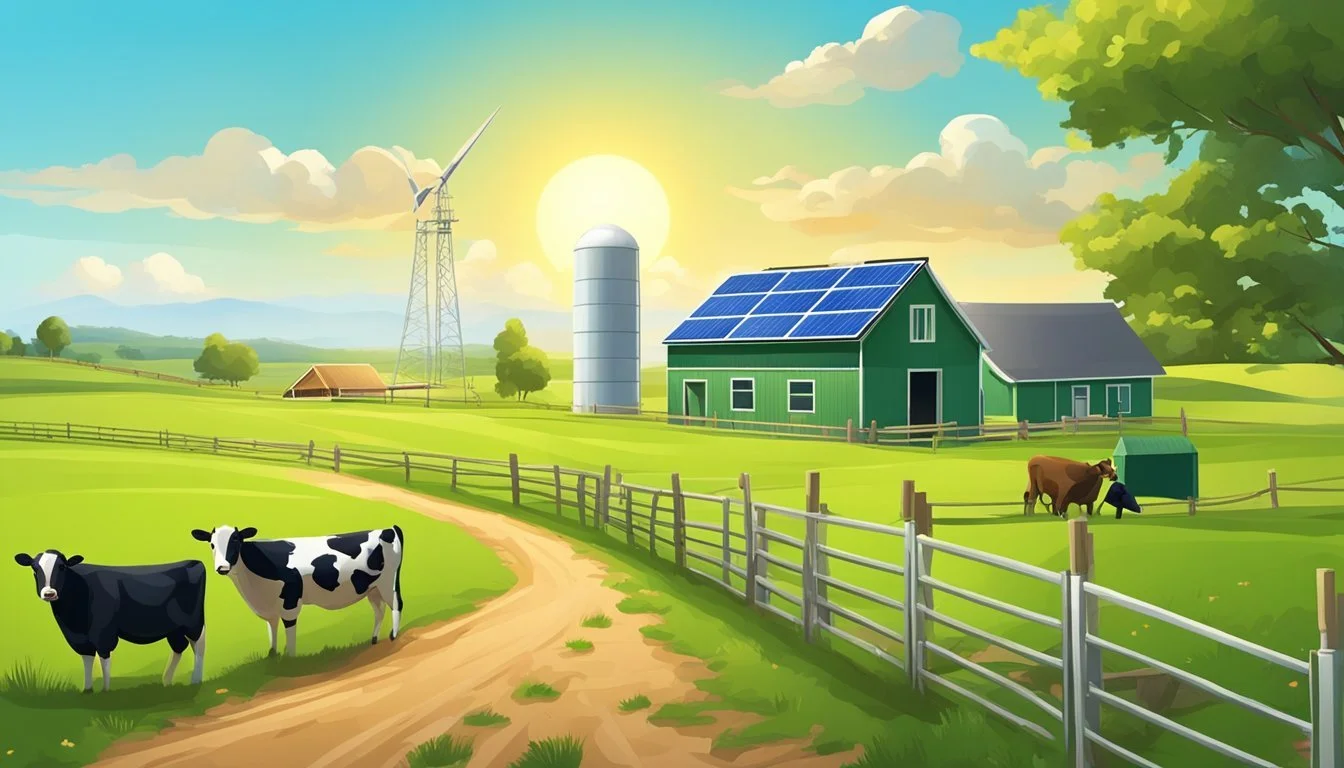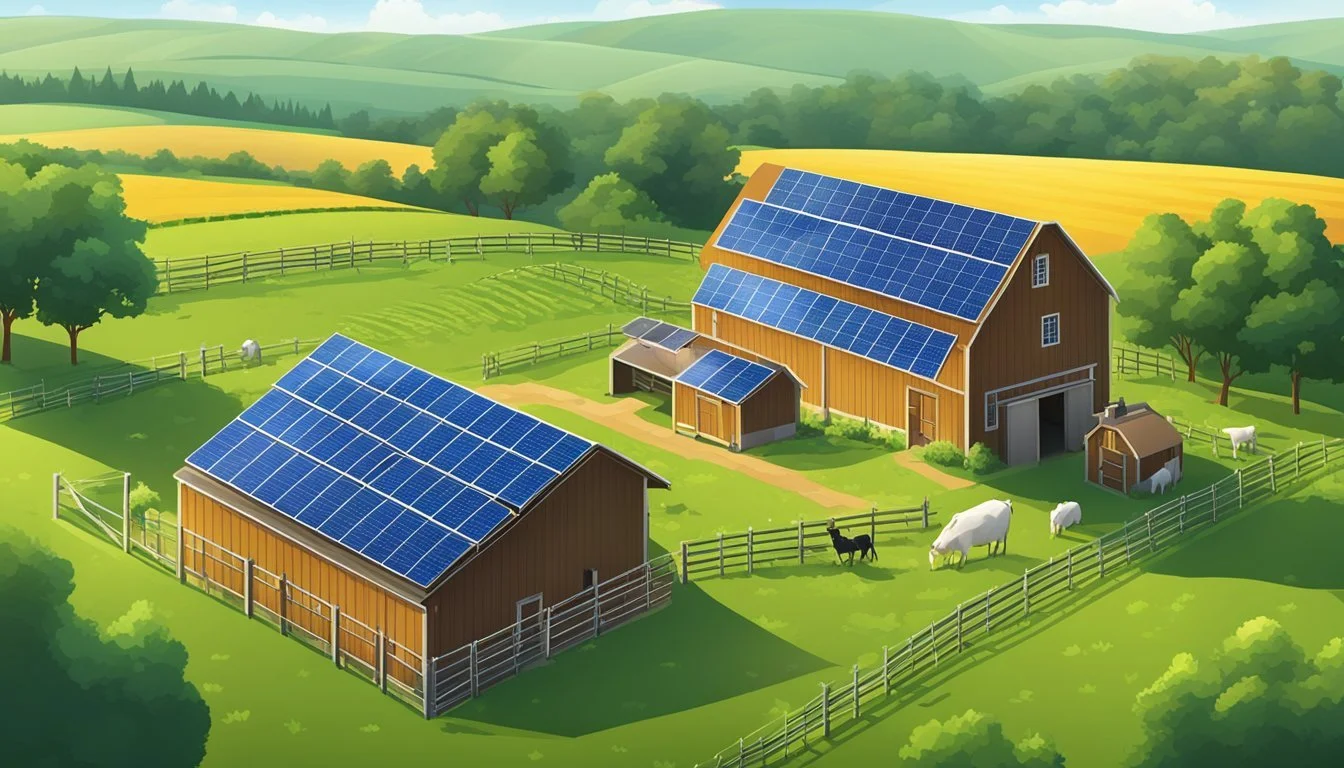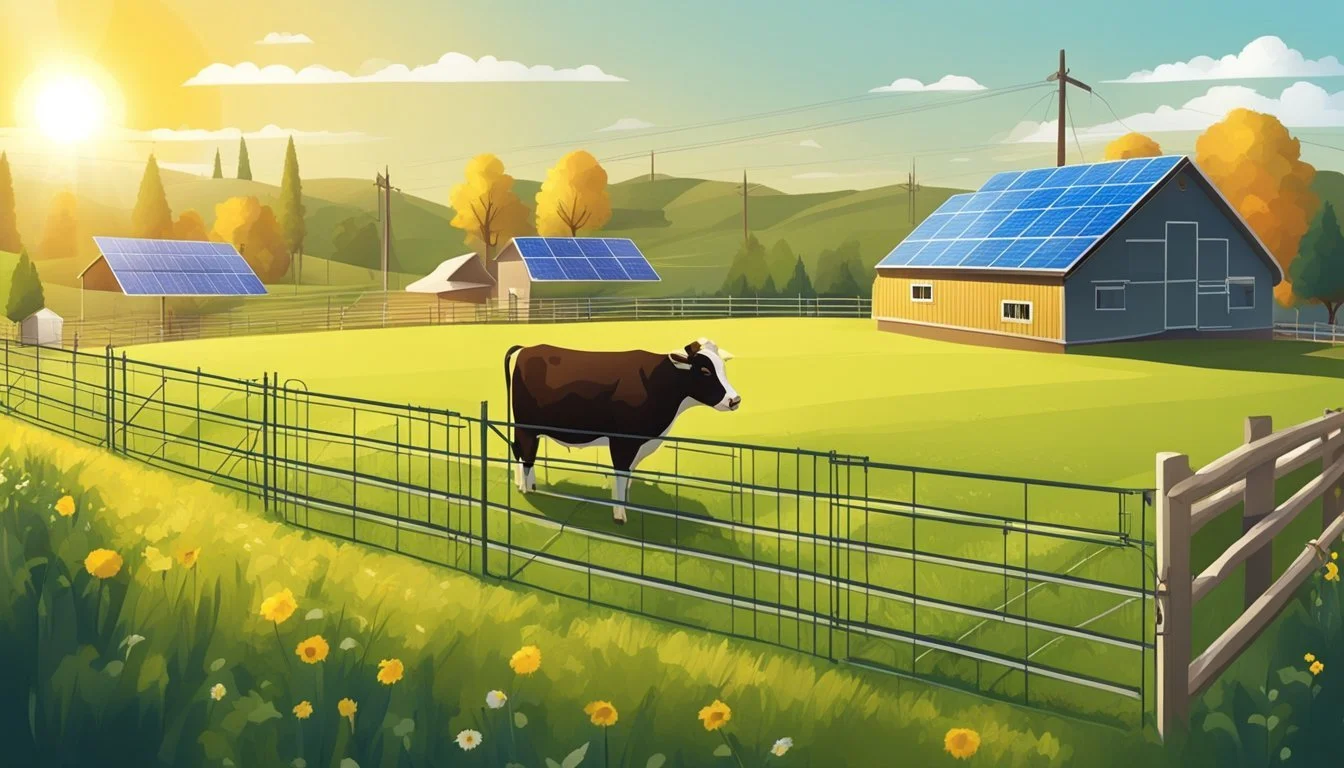Ultimate Guide to Solar-Powered Electric Fences
Ensuring Sustainable Livestock Management
Solar-powered electric fences provide an effective and sustainable method for livestock containment on homesteads. These systems harness the energy of the sun to maintain a mild electric charge, which serves as a psychological barrier for animals, preventing them from straying beyond their designated boundaries. The integration of solar technology delivers a renewable source of power, reducing the reliance on conventional electric sources or fossil fuels and minimizing the ecological footprint of agricultural practices.
The installation of a solar-powered electric fence involves setting up solar panels which capture and convert sunlight into electrical energy. This energy can either be used immediately to energize the fence or stored in batteries for continuous operation during nighttime or cloudy days. The self-sufficiency of such setups not only cuts down operational costs over time but also ensures uninterrupted containment even in remote locations without access to traditional power grids.
Considering livestock management, the utilization of electric fences powered by solar energy supports the well-being of the animals by offering a safe enclosure, protecting them from predators while also safeguarding crops and property from potential damage. This sustains both the livestock and the land, aligning with sustainable agricultural practices that aim to balance productivity with environmental stewardship.
Understanding Solar-Powered Electric Fences
Solar-powered electric fences offer a renewable and eco-friendly solution for effective livestock containment. This guide breaks down the components, benefits, and considerations necessary to understand and utilize this technology for homesteaders.
Components and Functionality
A solar-powered electric fence system primarily consists of a solar panel, battery, charger, and the fence wire itself. The solar panel converts sunlight into electrical energy, which is stored in the battery and regulated by the charger. This energy then flows through the wire and establishes a closed circuit. When an animal contacts the wire, it receives a short, sharp shock, which helps to contain or deter the animal.
Benefits of Solar-Powered Fencing
Solar-powered fencing is reliable, low maintenance, and cost-effective in the long run. Being powered by a renewable energy source, it diminishes the property's carbon footprint and overall greenhouse gas emissions. Additionally, these systems are versatile and can be set up in remote locations without access to grid power.
Limitations and Considerations
While solar fences are eco-friendly, their effectiveness can be unreliable in adverse weather conditions. The capacity of the battery and the size of the solar panel are critical to ensuring consistent power. Proper system sizing and maintenance are essential to offset the limitations posed by cloudy or rainy days.
Comparing Solar to Traditional Electric Fences
Compared to traditional electric fences that rely on grid power or generators, solar electric fences are more environmentally sustainable and can be more economical over time. However, they may have higher upfront costs due to the price of solar panels and batteries.
Environmental Impact
Solar-powered fences epitomize environmental sustainability, generating clean energy with little to no greenhouse gas emissions. They stand as an excellent alternative for reducing the carbon footprint of conventional fencing methods.
Choosing the Right System for Your Needs
Selecting a solar electric fence system requires considering the range, budget, energy demands, and fencing needs of your property. Factors like length of the fence, the fence line, and the grounding system must be evaluated to ensure efficient sizing of panels and batteries.
Fence Design and Layout
Effective solar-powered electric fencing involves strategic fence layout and the use of quality materials. Properly spaced fence posts and secure grounding systems are imperative to the fence’s effectiveness. The layout should maximize sunlight exposure to the solar panels while also accommodating the landscape and mobility of the livestock.
Planning and Installation
Before embarking on the installation of a solar-powered electric fence, one must understand the importance of proper planning and precise execution. The process involves site selection, choosing the right materials, assembling the components, and adhering to safety standards to ensure efficient and secure livestock containment.
Site Selection and Preparation
Site Selection
Sunlight Availability: Choose a site with adequate sunlight exposure essential for solar panels to function optimally.
Terrain: Assess the terrain for easy installation and maintenance. Avoid shaded areas that could hamper the performance of solar panels.
Site Preparation
Clearing Obstacles: Remove any debris or foliage that may block sunlight or interfere with the fence.
Measuring Area: Determine the perimeter of the area to estimate the length of fence wires and number of posts needed.
Selecting Components and Material
Components to Consider
Solar Panels: Ensure they are of sufficient size to power the fence.
Batteries: Select batteries with adequate storage capacity for nighttime use.
Solar Electric Fence Chargers: Choose a charger that is compatible with the size and type of your fence.
Materials
Fence Wires: Opt for conductive materials such as steel or aluminum.
Insulators: They are vital to prevent energy loss and should fit the type of posts being used.
Posts: The structure's stability depends on durable and robust posts, which may be wood, metal, or plastic.
Assembly and Installation
Steps for Assembling
Setting Posts: Install at regular intervals to ensure tension in the wires.
Attaching Insulators: Securely place insulators on posts.
Stringing Wires: Run fence wires through insulators, ensuring they are tight and straight.
Charger Setup: Install the solar electric fence charger at a point with maximum sunlight exposure.
Grounding: Proper grounding of the charger is critical for it to function.
Installation Tips
Accessibility: Install in a location that allows for easy maintenance.
Orientation: Orient the solar panel to maximize sunlight collection.
Security: Consider the height and spacing of wires for adequate security against predators.
Safety and Compliance
Safety Measures
Warning Signs: Install signs to alert individuals of the electric shock risk.
Regular Inspection: Ensure the system is routinely checked for damages or faults.
Compliance
Local regulations may dictate specific requirements for electric fencing. One should familiarize themselves with these and comply to avoid penalties or legal trouble.
By following thorough planning and methodical installation steps, a solar-powered electric fence can provide sustainable and reliable containment of livestock while minimizing environmental impact.
Operation and Maintenance
Effective operation and maintenance are crucial for ensuring the durability, efficiency, and reliability of a solar-powered electric fence system. Proper care reduces the risk of unreliable effectiveness and aids in optimizing the system's impedance characteristics for consistent performance.
Understanding Your Electric Fence Charger
The heart of a solar-powered electric fence is the solar fence charger, which must be matched to the size and type of fence you're operating. Solar chargers with minimal maintenance requirements typically convert solar energy into electrical pulses, sending them through the fence wire. It's important to understand the charger's capacity and whether it has low or high impedance to effectively contain livestock.
Routine Maintenance and Upkeep
Routine maintenance ensures long-term durability and system efficiency. Maintenance tasks include:
Checking solar panels for debris and cleanliness to maintain optimal energy absorption.
Inspecting wires and posts for damage or wear.
Replacing or repairing worn and broken components immediately.
Verifying battery health, if applicable, to prevent power lapses.
This regular upkeep minimizes the chance of sudden system failure and extends the life of the components.
Performance Monitoring and Troubleshooting
Monitoring the system's performance involves:
Observing voltage levels to ensure the fence is powered adequately.
Testing the impedance of the fence to confirm that it matches the charger's output, using a fence tester.
Identifying and remedying inefficiencies—such as shorts in the wire due to vegetation growth or broken insulators.
Prompt troubleshooting maintains the fence's effectiveness and prevents livestock from escaping due to power inconsistencies.
Upgrading and Expanding Your System
Scalability is an advantage of solar-powered electric fences. Consider these factors when upgrading or expanding:
Assess if additional solar panels or a more powerful solar charger is needed for expansion.
Calculate the higher initial investment against long-term sustainability and cost-effectiveness.
Ensure new components are compatible and meet the existing system’s maintenance standards to maintain reliability.
Thoughtful upgrades can enhance fence performance without a significant increase in maintenance demands.
Economics of Solar Electric Fencing
When considering the adoption of solar-powered electric fencing, an economic perspective is vital. Key financial aspects include evaluating the initial outlay against future savings, determining the return on investment, and exploring available financial incentives to offset costs.
Initial Costs vs Long-Term Savings
The upfront costs for installing a solar-powered electric fence system are typically higher than for conventional electric fencing, mainly due to the solar components. Prices can range significantly contingent upon system size and components quality. For instance, a reliable power supply such as a 12V solar electric fence charger could cover up to 48 kilometers and may cost around $499.95. Although the initial investment appears expensive, solar electric fencing can lead to substantial long-term savings. The switch to renewable energy eliminates recurring costs associated with non-renewable power sources, and the eco-friendly nature of solar power reduces the homestead's carbon footprint.
Key Factors Affecting Initial Investment:
Solar panels
Charge controller
Batteries
Electric fencing materials (wires, posts, insulators, etc.)
Long-Term Savings Components:
Reduction in Electricity Bills: Utilization of free, renewable energy from the sun.
Minimal Maintenance Costs: Less moving parts means fewer potential failures or repairs.
No Fuel Requirements: Elimination of fuel costs as compared to generator-powered systems.
Calculating Return on Investment
The return on investment (ROI) for a solar-powered electric fence is calculated by comparing the costs avoided by not depending on the grid or generators for electricity to the system's initial expense. This includes savings on electricity bills and reduced costs for maintenance and operation. A system's payoff time can be reduced further if the solar fence's capacity is maximized and it operates efficiently, supplying consistent and cost-effective power over the long term.
ROI Calculation Example:
Initial Investment: $1500 (Complete solar fencing system setup)
Yearly Savings on Electricity: $200
ROI: 1500 / 200 = 7.5 years
Incentives and Rebates
The installation of solar-powered systems often qualifies for incentives and rebates, which can significantly reduce the initial costs. These financial aids can derive from government programs, tax credits, or grants aimed at encouraging the adoption of renewable energy solutions. The availability and amount of such incentives vary by location, and interested parties should investigate the specific options available in their region to make solar electric fencing more affordable for their budget.
Common Financial Incentives Examples:
Federal Tax Credits
State-Sponsored Rebate Programs
Grants for Agricultural Equipment
Note on Incentives and Rebates:
Pre-Application Required: Often these incentives require pre-qualification or application steps before system installation.
Time-Sensitive: Incentives may be available for a limited time, subject to government policies and budget constraints.
Advanced Considerations
In the realm of sustainable livestock containment, advanced considerations for solar-powered electric fences revolve around ensuring resilience and versatility to address various homestead needs beyond basic containment.
Integrating with Off-Grid Solutions
Integrating solar-powered electric fencing with off-grid power solutions can provide a homestead with a reliable power supply even during power outages. A solar system with sufficient battery storage capacity is critical for maintaining the electric fence's functionality during periods with low sunlight. Homesteaders should evaluate their energy demands to determine the appropriate size for their solar system, considering all appliances and power consumption within the property.
Battery Storage: Necessary to store excess energy for use during nighttime or low-light conditions.
Solar Generator: A complement to solar panels, able to provide AC outlets for other appliances.
Customizing Systems for Multifunctionality
Going beyond simple containment, a solar electric fence can be adapted for multifunctional use. Customization might include incorporating different power levels in various fence sections to cater to different types of animals or adding lighting and security features that also draw from the solar system. This ensures that the energy use is maximized, and the investment in solar technology serves multiple purposes.
Multifunctional Use: Electric fencing can work in tandem with solar-powered security systems or watering systems.
Energy Use Adjustments: Varying energy demands may necessitate adjusting solar panel arrays or battery storage capabilities.
Adapting to Changing Energy Use
Adapting solar-powered systems to meet changing energy demands ensures longevity and cost-effectiveness. When energy consumption patterns change, such as when expanding the homestead or adjusting for seasonal variations, the solar system and electric fencing must be evaluated and modified accordingly. There is no energy storage loss in properly maintained batteries, and efficient solar generators can provide additional energy buffering in remote locations.
Reliable Power Supply: Scaled to meet the needs of growth or reduced energy use.
Remote Locations: Especially beneficial where grid electricity is not an option; customization is key to ensuring the system caters to the specific conditions of the location.
By concentrating on these advanced considerations, homesteaders can ensure their solar-powered electric fence systems are robust, adaptable, and capable of serving the farm's needs now and in the future.
Conclusion
Solar-powered electric fences offer an environmentally friendly and efficient solution for livestock containment. These fences harness solar energy, providing a sustainable way of securing animals while reducing reliance on traditional power sources. The installation is straightforward, and they require minimal maintenance, lowering long-term costs for the farmer.
Key Aspects of Solar-Powered Electric Fences:
Sustainability: Utilizing renewable energy, these fences are ideal for eco-conscious farmers.
Reliability: They are dependable, keeping livestock secure even during power outages, due to battery backups.
Ease of Installation: Unlike conventional fences, there's no need for proximity to electricity grids.
Farmers should consider the affordability of solar electric fences over time, the potential for savings on energy costs, and the added security against predators. The adaptability of these systems allows them to be implemented in various settings, from small-scale homesteads to large farming operations.
Benefits in Brief:
Energy Independence: Less dependency on external electricity supplies.
Cost-Effective: Reduced energy bills and comparably low maintenance expenses.
Flexibility: Can be set up in remote locations and reconfigured as needed.
By adopting solar-powered electric fences, livestock farmers not only secure their animals but also contribute to a sustainable future. This integration of renewable energy technology into farming practices is a step forward in agricultural innovation and environmental responsibility.





